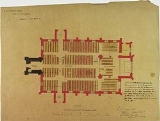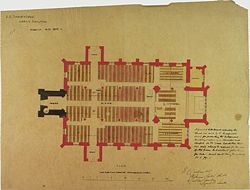
Richard Cromwell Carpenter
Encyclopedia

Family
Richard was the son of Richard (baptized 20 Jul 1788 in St. Giles, CripplegateCripplegate
Cripplegate was a city gate in the London Wall and a name for the region of the City of London outside the gate. The area was almost entirely destroyed by bombing in World War II and today is the site of the Barbican Estate and Barbican Centre...
and Sophia (Page) Carpenter. His parents married in 1804 in St. James
St James Church, Clerkenwell
St James Church, Clerkenwell is an Anglican parish church in Clerkenwell, London, England.- Nunnery of St Mary: c. 1100 - 1539 :The parish of St James, Clerkenwell, has had a long and sometimes lively history. The springs which give Clerkenwell its name are mentioned during the reign of Henry II...
, Clerkenwell
Clerkenwell
Clerkenwell is an area of central London in the London Borough of Islington. From 1900 to 1965 it was part of the Metropolitan Borough of Finsbury. The well after which it was named was rediscovered in 1924. The watchmaking and watch repairing trades were once of great importance...
, London, England and lived a moderately affluent family life in Russell Square
Russell Square
Russell Square is a large garden square in Bloomsbury, in the London Borough of Camden. It is near the University of London's main buildings and the British Museum. To the north is Woburn Place and to the south-east is Southampton Row...
, London.
Richard was born 21 Oct 1812 in Russell Square, London and died 27 Mar 1855. He married Amelia Dollman, who was born about 1818 at Loders, Dorset
Dorset
Dorset , is a county in South West England on the English Channel coast. The county town is Dorchester which is situated in the south. The Hampshire towns of Bournemouth and Christchurch joined the county with the reorganisation of local government in 1974...
.
His son Richard Herbert Carpenter
Richard Carpenter (architect)
Richard Herbert Carpenter was an eminent Victorian architect from England.Richard was born 1841 in St. Pancras, London, Middlesex, England and died in 1893...
, (born 1841 in St. Pancras
St Pancras, London
St Pancras is an area of London. For many centuries the name has been used for various officially-designated areas, but now is used informally and rarely having been largely superseded by several other names for overlapping districts.-Ancient parish:...
, London, died 1893),was a Gothic revival ecclesiastical architect.
Career
Richard Cromwell Carpenter was a member of the Cambridge MovementCambridge Movement
The Cambridge Movement was a conservative ideological school of thought closely related to the Oxford Movement.- History :It has been claimed the origins of the movement emanate from the teachings of the Cambridge University professor and intellectual Desiderius Erasmus...
— a group of Tractarians devoted to the return of medieval forms of liturgy
Liturgy
Liturgy is either the customary public worship done by a specific religious group, according to its particular traditions or a more precise term that distinguishes between those religious groups who believe their ritual requires the "people" to do the "work" of responding to the priest, and those...
and church building within the Church of England
Church of England
The Church of England is the officially established Christian church in England and the Mother Church of the worldwide Anglican Communion. The church considers itself within the tradition of Western Christianity and dates its formal establishment principally to the mission to England by St...
. Thus, Carpenter championed the move away from the more classical
Classicism
Classicism, in the arts, refers generally to a high regard for classical antiquity, as setting standards for taste which the classicists seek to emulate. The art of classicism typically seeks to be formal and restrained: of the Discobolus Sir Kenneth Clark observed, "if we object to his restraint...
Palladian-influenced architecture of the 18th century and early 19th century towards the Gothic style which was to typify the Victorian period
Victorian era
The Victorian era of British history was the period of Queen Victoria's reign from 20 June 1837 until her death on 22 January 1901. It was a long period of peace, prosperity, refined sensibilities and national self-confidence...
.
He first exhibited at the Royal Academy
Royal Academy
The Royal Academy of Arts is an art institution based in Burlington House on Piccadilly, London. The Royal Academy of Arts has a unique position in being an independent, privately funded institution led by eminent artists and architects whose purpose is to promote the creation, enjoyment and...
in 1830; his later buildings included St. Paul, Brighton, and St. Mary Magdalen, Munster Square, London.
Carpenter founded the family firm "Carpenter and Slater" with his architectural partner William Slater
William Slater
William Slater was an English professional cricketer. His brother was John Slater , also of Sussex, who played in 7 matches from 1825 to 1829.-Career:...
. The company specialised in church design and restoration. The church of St. Simon & St. Jude at Earl Shilton
Earl Shilton
Earl Shilton is a small town in Leicestershire, England, some from Hinckley and about 10 miles from Leicester, with a population of around 9,000 .-History:...
was designed by Carpenter between 1854–1856, as was St. Paul's Church at Brighton
Brighton
Brighton is the major part of the city of Brighton and Hove in East Sussex, England on the south coast of Great Britain...
.
One of his most notable works was Lancing College
Lancing College
Lancing College is a co-educational English independent school in the British public school tradition, founded in 1848 by Nathaniel Woodard. Woodard's aim was to provide education "based on sound principle and sound knowledge, firmly grounded in the Christian faith." Lancing was the first of a...
in Sussex (1854). The founder of the college Nathaniel Woodard
Nathaniel Woodard
Nathaniel Woodard was a priest in the Church of England. He founded 11 schools for the middle classes in England whose aim was to provide education based on sound principle and sound knowledge, firmly grounded in the Christian faith...
described Carpenter's great chapel there as an "immemorial creed in stone", and "considered by competent judges to be the finest example of a Gothic Church since the Middle Ages, and in its gracefulness of detail and majesty of proportion is an enduring monument to the genius of Richard Carpenter, its architect".
Carpenter died shortly after submitting grandiose plans for the new Inverness Cathedral
Inverness Cathedral
Inverness Cathedral , also known as the Cathedral Church of Saint Andrew is a cathedral of the Scottish Episcopal Church situated in the city of Inverness in Scotland...
; as a consequence his plan was not executed.
Today, perhaps, Carpenter's chief claim to fame is having been the teacher and mentor of the eminent New Zealand
New Zealand
New Zealand is an island country in the south-western Pacific Ocean comprising two main landmasses and numerous smaller islands. The country is situated some east of Australia across the Tasman Sea, and roughly south of the Pacific island nations of New Caledonia, Fiji, and Tonga...
architect Benjamin Mountfort
Benjamin Mountfort
Benjamin Woolfield Mountfort was an English emigrant to New Zealand, where he became one of that country's most prominent 19th century architects. He was instrumental in shaping the city of Christchurch's unique architectural identity and culture, and was appointed the first official Provincial...
, who was one of his pupils. Heavily influenced by Carpenter's form of Gothic revival, Mountfort took many of Carpenter's ideals to New Zealand where he became the country's leading church architect, with over forty churches and other buildings in the Gothic style attributed to him. Many of Mountfort's New Zealand designs, especially those in the province of Canterbury
Canterbury, New Zealand
The New Zealand region of Canterbury is mainly composed of the Canterbury Plains and the surrounding mountains. Its main city, Christchurch, hosts the main office of the Christchurch City Council, the Canterbury Regional Council - called Environment Canterbury - and the University of Canterbury.-...
, were openly borrowed from Carpenter.
One of Carpenter's designs, based on his All Saints Church, Brighton (since demolished) was executed in modified form in the United States, where it survives as St. Mark's Episcopal Church in Philadelphia, Pennsylvania
Philadelphia, Pennsylvania
Philadelphia is the largest city in the Commonwealth of Pennsylvania and the county seat of Philadelphia County, with which it is coterminous. The city is located in the Northeastern United States along the Delaware and Schuylkill rivers. It is the fifth-most-populous city in the United States,...
. His plans for a "town-church" approved by the Cambridge Camden Society
Cambridge Camden Society
The Cambridge Camden Society, later known as the Ecclesiological Society from 1845 when it moved to London, was a learned architectural society founded in 1839 by undergraduates at Cambridge University to promote "the study of Gothic Architecture, and of Ecclesiastical Antiques." Its activities...
were provided to the Saint Mark's vestry and given to architect John Notman
John Notman
John Notman was a Scottish-born American architect, who settled in Philadelphia, Pennsylvania. He is remembered for his churches, and for popularizing the Italianate style and the use of brownstone.-Career:...
, who altered them to better suit the North American climate and site. The finished church is said to resemble Carpenter's Saint Stephen's, Rochester Row, Vincent Square
Vincent Square
Vincent Square is a large grass-covered square in Westminster, London, England, covering 13 acres. It provides playing fields for Westminster School, which privately owns it....
, Westminster
Westminster
Westminster is an area of central London, within the City of Westminster, England. It lies on the north bank of the River Thames, southwest of the City of London and southwest of Charing Cross...
church. A photo essay of the Saint Stephen's, Rochester Row church is viewable at an offsite link.
External links
- Carpenter's influence in New Zealand: http://library.christchurch.org.nz/Childrens/EarlyChristchurch/BenjaminMountfortandtheGothicRevival.asp

